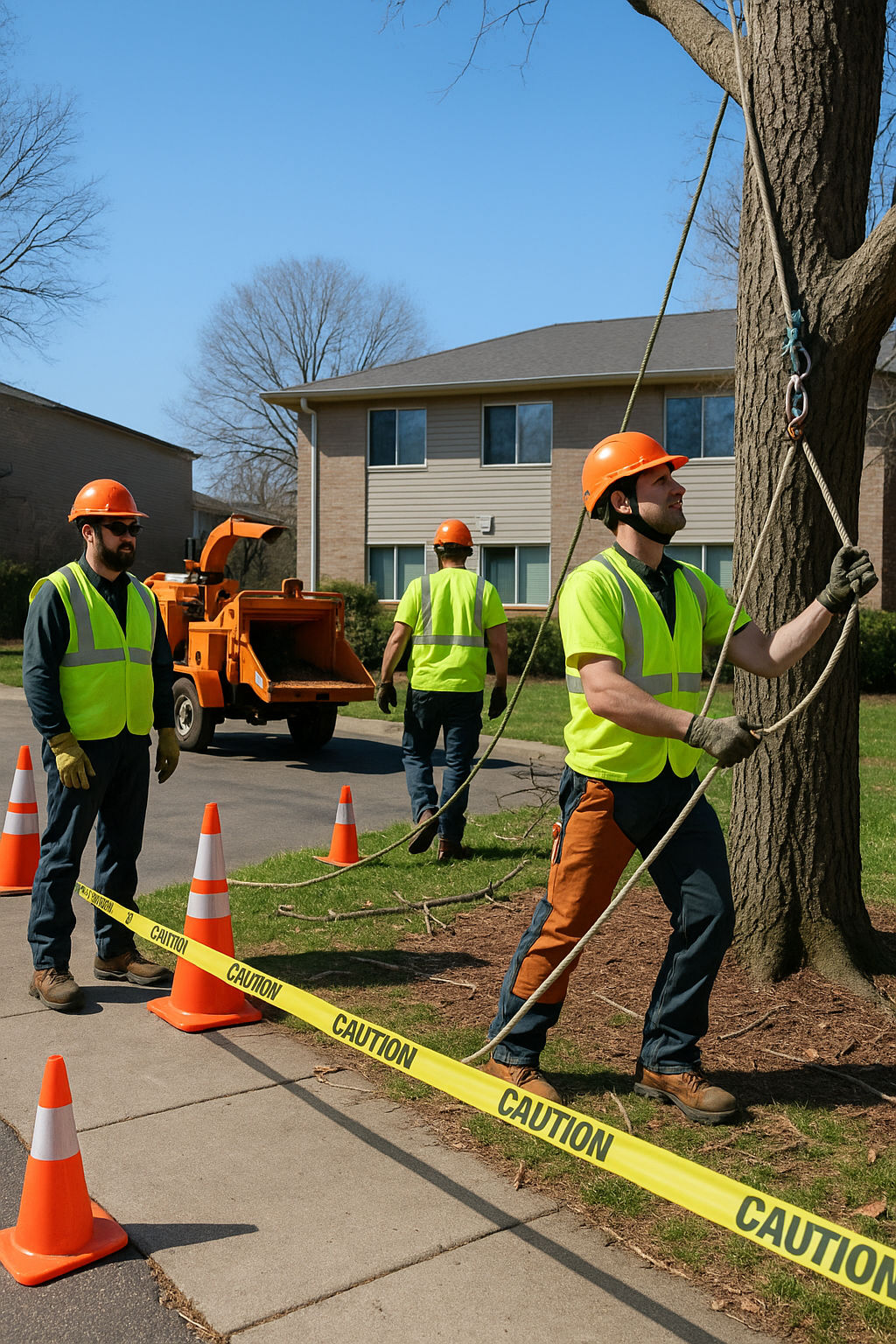Ground Crew Safety: What Every Property Manager Should Know

Tip Top ground crew sets up a secure rigging zone to keep properties and people safe during tree work
If you manage properties with trees – whether it’s a residential complex, a commercial lot, or an HOA – you’ve probably seen tree crews on site. There’s the hum of chippers, the flash of high-vis vests, and the rhythm of ropes moving limbs from high above. From the sidewalk, it might look like organized chaos. But when it’s done right, every movement is part of a careful, coordinated plan.
At Tip Top, we’ve been working alongside Lancaster’s property managers for decades. We know what’s riding on every job: safety, liability, your reputation, and finishing the work without any surprises. That all starts with understanding the ground crew – the folks making sure everything runs smoothly down below.
Because in tree care, safety doesn’t begin at the top of the tree. It starts at ground level.
Tree work isn’t just about climbing with chainsaws and fancy knots. The ground crew has one of the most important – and sometimes most overlooked – roles on the site. They’re responsible for rigging, redirecting, chipping, hauling, and making sure the area stays safe for pedestrians, cars, and buildings.
And in many cases, they’re the ones closest to your tenants, your storefront, or that very expensive glass patio door.
A ground crew that isn’t trained or protected puts more than themselves at risk. It can create liability issues for you as the property manager, especially if something goes wrong.
Here are five key things every property manager should know before the next tree project starts.
Whenever limbs are being lowered by rope, there’s a defined area on the ground where those limbs could swing, shift, or drop. That’s called the rigging zone. A professional crew will always set it up clearly, marking it off with cones, signs, or caution tape. Nobody should enter without the go-ahead from the crew leader.
Want to stay ahead of the game? Ask the crew where the rigging zone will be before the work begins.
A good crew doesn’t just work hard – they work smart. You’ll often see a designated spotter keeping an eye on the work area, especially during rigging or while operating the chipper. Visual or verbal signals are used to coordinate who does what and when.
If there’s no communication happening and no one watching for movement or bystanders, that’s a red flag.
At Tip Top, our ground crew gear includes:
- ANSI-certified hard hats
- Cut-resistant chaps
- High-visibility vests
- Ear and eye protection
And yes, we wear it even in 100-degree Lancaster heat. If a company skips personal protective equipment, they might be cutting corners elsewhere too. Don’t take that risk.
Chippers are powerful tools and, frankly, the most dangerous piece of equipment on-site. Loading them requires serious focus and training. The area around the chipper should be treated like a no-go zone unless you’re part of the crew.
If a tree crew is working near a common area, entrance, or walkway, make sure there are temporary signs directing people around the zone. This helps prevent accidents and confusion.
As the property manager, you play a big role in keeping the worksite safe – and your part is pretty straightforward:
- Move vehicles and outdoor furniture from the work area
- Let tenants or employees know what’s happening ahead of time
- Keep kids, pets, and curious onlookers out of the drop zone
- Confirm that the tree service has valid insurance and worker’s comp coverage
Tree safety is a team effort. When everyone’s on the same page, the job goes faster, smoother, and safer.
You don’t need to know everything about tree work. But you do need to ask smart questions before hiring a crew. Here are some of the big ones:
- Are your ground crew trained in rigging and drop zone safety?
- How do you mark off and control the work zones?
- Do you have up-to-date general liability and worker’s comp insurance?
- Who will be the on-site lead or foreman?
- How will you keep tenants, staff, or customers safe during the work?
If the crew hesitates, avoids the questions, or says “don’t worry about it,” that’s your cue to look elsewhere.
We’ve seen the difference good safety practices make. And we’ve also seen what happens when they’re ignored.
One job had a misjudged anchor point that sent a large limb swinging a little too close to a resident’s car. Another time, a poorly marked drop zone caused confusion with maintenance staff walking through during rigging. Thankfully, no one was hurt – but things could have gone very differently.
When safety comes first, everyone benefits. There’s less risk, fewer delays, no unnecessary property damage, and happier people on all sides.
We don’t guess. We plan. Our crews arrive in uniform, brief every job site, and follow strict protocols from the moment they park the truck to the final rake-up. Whether it’s a one-time removal or ongoing maintenance across multiple properties, we’ll walk the site with you, identify any concerns, and make sure the job runs safely and efficiently.
Because good tree care isn’t just about cutting – it’s about protecting the people and property below.
Before you bring in a tree crew, run through this quick checklist:
- Ask for insurance and worker’s comp documentation
- Find out how they mark and enforce rigging and drop zones
- Confirm all crew wear appropriate safety gear
- Make sure they’ll block or redirect access to walkways if needed
- Let your tenants or team know what to expect
Need a second opinion or just want peace of mind?
Give Tip Top Arborists a call. We’ve been keeping Lancaster’s trees in tip-top shape since 1976.
